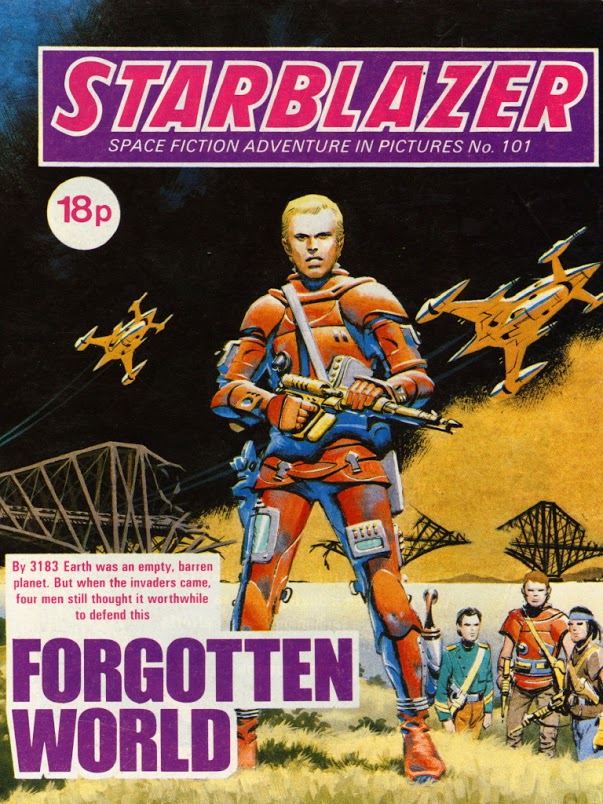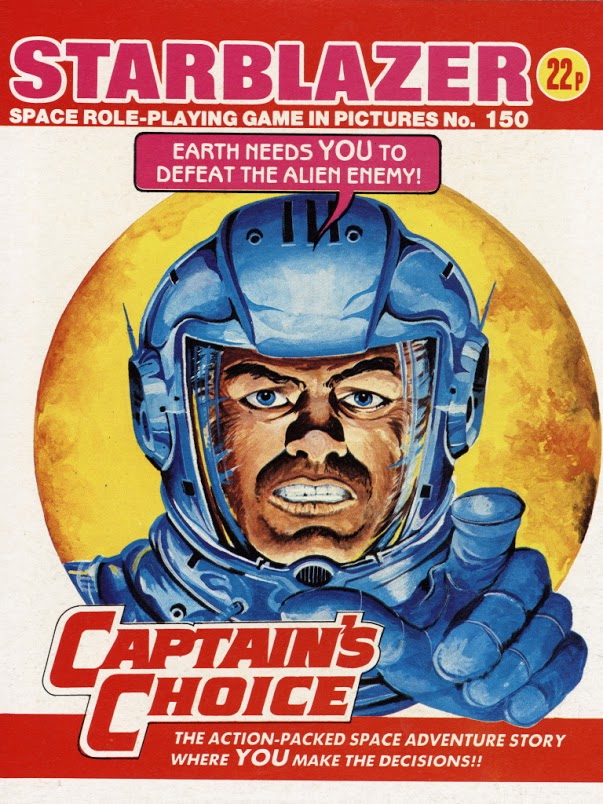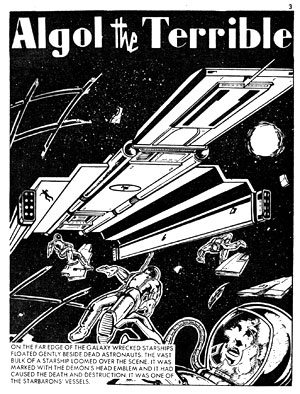Jeremy Briggs ponders DC Thomson’s secretive nature about its creators down the years, and explores the secrets of its science fiction title Starblazer, whose creators included a young Grant Morrison and artist Ian Kennedy…
There is a society so secret that most of its members will take their allegiance of it to their graves. Few talk of their time in this society to all save their close family and friends – their names remaining unknown to the wider world. A few have publicly admitted to membership and some will even go so far as to advertise the fact, yet these brave souls remain few and far between. Many of those same members will never even have made the long trek north of the Fleet River, over the Red Diamond Bridge and through the Kingdom of Flutes to the society’s fabled headquarters in the City of Jute…
As amusing as it is to parody the perceived secrecy of Dundee-based publishers DC Thomson, just who did write their comics?
If only we knew. If only they were as easy to discover as, for example, the creators 2000AD. But perhaps we are just too used to all those credit boxes in The Galaxy’s Greatest Comic.
British comic creators have long had their identities shrouded in secrecy, of course. At first, 2000AD did not include credits when it was initially published and its stable mates, Battle and new Eagle, did not maintain a consistent editorial policy on whether to publish them or not. Before 2000AD such credits did not really exist. The publishers of the original Eagle let some of their artists sign their work, but not all.
Yet perhaps that last sentence should be phrased differently – not all of the original Eagle’s artists signed their work. Was it that they considered the work so unimportant? After all the artists were turning out pages upon pages of the same strips week in, week out. Pages that were not returned to them after publication, a publication that lasted a mere week. Yet even original Eagle rarely credited the writers of the stories, but then neither did Boy’s World, TV Express, Tiger or Lion
So who wrote “Dan Dare”? Well, various people did — including some of the artists. We now know because, after all, it is probably the most researched pre-2000AD British strip. Eric Eden? Didn’t he draw “Lady Penelope” in that Gerry Anderson girl’s comic? Chad Varah? Surely not — he set up The Samaritans!
How about a different title? Look and Learn for instance. Who wrote “Trigan Empire”? Michael Butterworth! You mean the guy who wrote those Space:1999 paperback novelisations?
Today, DC Thomson allow the artists in Commando to sign their work. The names of John Ridgway and Ian Kennedy may be familiar to readers of Doctor Who Magazine or Blake’s 7 Monthly where they were credited, yet how many people have heard of Jose Maria Jorge before? His style is similar to Ridgway’s, with Kennedy’s attention to detail on aircraft, and his artwork stands out. But who writes the stories he illustrates? Even now we still don’t really know.
And yet, there was one occasion when Thomson’s secrecy slipped – and slipped big time. Deliberately.
Starblazer was as close as DC Thomson got to taking on the challenge of IPC’s 2000AD. Between Issue 1 in April 1979 and the final issue, 281 in January 1991, a single black and white 64 page story would hide behind a painted colour cover. What started as a fairly straightforward science-fiction version of Thomson’s digest-size Commando comic would mutate over the course of its history. Its initial tag line of “Space Fiction Adventure In Pictures” would conclude its run with “Fantasy Fiction In Pictures”, with the inclusion of more sword and sorcery elements in the later issues.
The only real hiccup along the way was an attempt, in 1985, to emulate the then popular “Fighting Fantasy” style of single player role-playing games in a comic – “Space Role-Playing Game In Pictures”. The few issues in which this was tried required the reader to jump around the story between different frames making decisions at different points to influence the story. It was confusing, and definitely annoying. That experiment didn’t last long.
In its dying days, it ran an ongoing single page feature entitled “Starblazer: The Definitive History”. Over the course of 12 issues beginning with Issue 268, along with a sentence or two of editorial on each page, the author and artist of each Starblazer was listed. Based on their surnames, most of the artists were non-UK based. Their Christian names were missing, yet the majority of the writers and the few British artists were at least granted their initials. Some are familiar: G.T. Morrison is of course better known as Grant and M. McMahon as Mick, but others are not so well known. Who are J. Speer or C. Harris, for example? Mick McMahon’s artwork only graced the pages of Starblazer once, in Issue 71, in a story called “Jaws of Death” written by D. Broadbent and with a cover by Keith Robson. Grant Morrison however is one of the few writers to publicly admit to writing for Starblazer. His first story was “Algol the Terrible” in issue 15 which he drew as well as writing.
Yet this credit listing for Starblazer does seem to have been a one-off. Whilst Commando now publish a yearly listing of titles, there has never been an equivalent credit listing. Even the Commando: The Dirty Dozen collection neglected to list the writers and artists of the reprinted stories.
DC Thomson’s attitude toward its creators may seem old-school, traditional, perhaps born of a commerical need to protect their creators’ identity from potential poaching from other comics publishers — something they no longer need to fear. With The Dandy, The Beano and Commando they continue to publish the three longest surviving British comics, at a time when comics have become mainly gift-clad pre-school titles.
Still, it would be nice to know who writes and illustrates their stories, but the fact that they are still here to be read is the main thing. Long may they continue.
This page is part of our Starblazer section on downthetubes.
• Click Here for Jeremy Briggs article on Starblazer: Blazing Through the Secrecy
Jeremy Briggs ponders DC Thomson’s secretive nature about its creators down the years, and explores the secrets of its science fiction title Starblazer, whose creators included a young Grant Morrison and artist Ian Kennedy…
• Click Here for From the Command Deck: Starblazer editor Bill McLoughlin’s history of the title
• Click Here for Starblazer Ray Aspden’s feature on writing for the title
• Click Here for Starblazer Recalled: Forgotten Fantasy Fiction – With Pictures by series writer Mike Chinn
• Click Here for a complete Starblazer Cover Gallery (off site)
Cover scans for these Starblazer articles with thanks to ‘Gary’
Starblazer Checklist
Issues 1 – 75 | Issues 76 – 150 | Issues 151 – 200 | Issues 201 – 250 | Issues 251 – 281 | Starblazer Abroad
External Links
• Fish 1000 Comics: Grant Morrison’s Starblazer work
• Vic Whittle’s Starblazer Page
Steve Holland is amazed at how many people remember Starblazer, noting the pocket books appeared as “regular as clockwork throughout the 1980s at the rate of two new titles a month so I guess over the nearly twelve years it appeared a vast army of young science fiction fans, high on Star Wars or Battlestar Galactica, sought them out.”
Starblazer fan Douglas Nicol began this article on the internet’s contributor-based encyclopedia
This article is © 2006 Jeremy Briggs and must not be reprinted without his express permission. Starblazer is © DC Thomson. The images featured in this article are done so for review purposes only and no copyright infringement is intended.





Leave a Reply